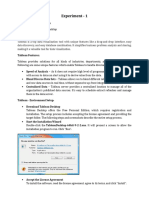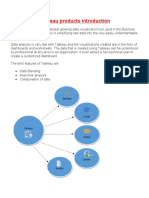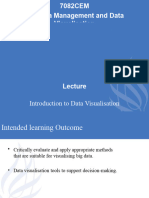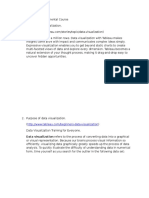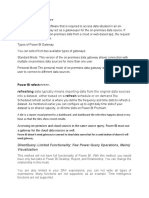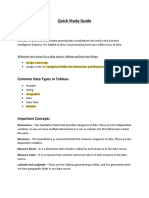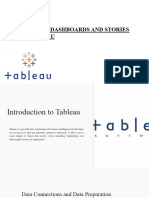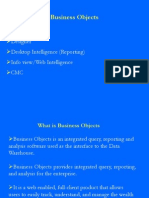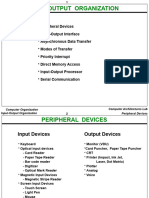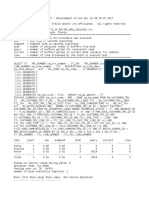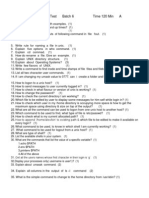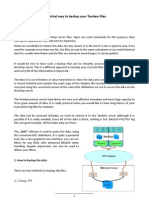Professional Documents
Culture Documents
TABLEAU
TABLEAU
Uploaded by
Shweta Saini0 ratings0% found this document useful (0 votes)
3 views3 pagesCopyright
© © All Rights Reserved
Available Formats
TXT, PDF, TXT or read online from Scribd
Share this document
Did you find this document useful?
Is this content inappropriate?
Report this DocumentCopyright:
© All Rights Reserved
Available Formats
Download as TXT, PDF, TXT or read online from Scribd
Download as txt, pdf, or txt
0 ratings0% found this document useful (0 votes)
3 views3 pagesTABLEAU
TABLEAU
Uploaded by
Shweta SainiCopyright:
© All Rights Reserved
Available Formats
Download as TXT, PDF, TXT or read online from Scribd
Download as txt, pdf, or txt
You are on page 1of 3
Tableau is a business intelligence software that visually represents data from
varied sources to create interactive and shareable dashboards.
What are the advantages of Tableau?
Some of the advantages of using Tableau:
• Data visualization: Rather than having complex computations over an Excel sheet,
Tableau provides beautiful insights, data blending, and dashboarding derived from
the data.
• Create interactive visualizations: Tableau provides a drag-n-drop facility to
quickly let the users interact with the data. You can check some of the templates
created using Tableau in the Tableau gallery. With Tableau’s gallery of templates,
you can choose your option and customize it. With data visualization features, you
can easily embed tons of information in the form of infographics that appeal to the
audience.
• Ease of implementation: With drag-and-drop options, Tableau is reportedly easier
to use. This is one such tool that you can learn without having any coding
background or experience in Python, Business objects, or DOMO.
• Handle large amounts of data: Tableau is competent enough to handle millions of
rows without affecting the dashboard performance.
• Integration of scripting languages: With Tableau, you can perform complex data
computations using scripting languages like Python and R by importing some visuals
or packages.
What are different Tableau products?
Tableau like other BI tools has a range of products:
• Tableau Desktop: Desktop product is used to create optimized queries out from
pictures of data. Once the queries are ready, you can perform those queries without
the need to code. Tableau desktop encompasses data from various sources into its
data engine and creates an interactive dashboard.
• Tableau Server: When you have published dashboards using Tableau Desktop, Tableau
servers help in sharing them throughout the organization. It is an enterprise-level
feature that is installed on a Windows or Linux server.
• Tableau Reader: Tableau Reader is a free feature available on Desktop that lets
you open and views data visualizations. You can filter or drill down the data but
restricts editing any formulas or performing any kind of actions on it. It is also
used to extract connection files.
• Tableau Online: Tableau online is also a paid feature but doesn’t need exclusive
installation. It comes with the software and is used to share the published
dashboards anywhere and everywhere.
• Tableau Public: Tableau public is yet another free feature to view your data
visualizations by saving them as worksheets or workbooks on Tableau Server.
measures and dimensions?
In Tableau, when we connect to a new data source, each field in the data source is
either mapped as measures or dimensions. These fields are the columns defined in
the data source. Each field is assigned a dataType (integer, string, etc.) and a
role (discrete dimension or continuous measure).
Measures contain numeric values that are analyzed by a dimension table. Measures
are stored in a table that allows storage of multiple records and contains foreign
keys referring uniquely to the associated dimension tables.
While Dimensions contain qualitative values (name, dates, geographical data) to
define comprehensive attributes to categorize, segment, and reveal the data
details.
What are continuous and discrete field types?
Tableau’s specialty lies in displaying data differently either in continuous format
or discrete. Both of them are mathematical terms used to define data where
continuous means without interruptions and discrete means are individually separate
and distinct.
While the blue color indicates discrete behavior, the green color indicates
continuous behavior. On one hand, the discrete view defines the headers and can be
easily sorted, while continuous defines the axis in a graph view and cannot be
sorted.
Tell me the different connections to make with a dataset?
There are two types of data connections in Tableau:
LIVE: Live connection is a dynamic way to extract real-time data by directly
connecting to the data source. Tableau directly creates queries against the
database entries and retrieves the query results in a workbook.
EXTRACT: A snapshot of the data, extract the file (.tde or .hyper file) contains
data from a relational database. The data is extracted from a static source of data
like an Excel Spreadsheet. You can schedule to refresh the snapshots which are done
using the Tableau server. This doesn’t need any connection with the database.
What are the supported file extensions in Tableau?
The supported file extensions used in Tableau Desktop are:
• Tableau Workbook (TWB): contains all worksheets, story points, dashboards, etc.
• Tableau Data Source (TDS): contains connection information and metadata about
your data source
• Tableau Data Extract (TDE): contains data that has been extracted from other data
sources.
• Tableau Packaged Workbook (TWBX): contains a combination of the workbook,
connection data, and metadata, and the data itself in the form of TDE. It can be
zipped and shared.
• Tableau Packaged Data Source (TDSX): contains a combination of different files.
• Tableau Bookmark (TBM): to earmark a specific worksheet.
Data blending in Tableau?
Data blending is viewing and analyzing data from multiple sources in one place.
Primary and secondary are two types of data sources that are involved in data
blending.
How do you generally perform load testing in Tableau?
Load testing in Tableau is done to understand the server’s capacity with respect to
its environment, data, workload, and use. It is preferable to conduct load testing
at least 3-4 times in a year because with every new user, upgrade, or content
authoring, the usage, data, and workload change.
Tabjolt was created by Tableau to conduct point-and-run load and performance
testing specifically for Tableau servers. Tabjolt:
• Automates the process of user-specified loads
• Eliminates dependency on script development or script maintenance
• Scales linearly with an increase in the load by adding more nodes to the cluster
What are the various types of filters in Tableau?
Tableau has 6 different types of filters:
• Extract Filter: This filter retrieves a subset of data from the data source.
• Dimension Filter: This filter is for non-aggregated data (discrete).
• Data Source Filter: This filter refrains users from viewing sensitive information
and thus reduces data feeds.
• Context Filter: This filter creates datasets by applying presets in Tableau.
• Measure Filter: This filter applies various operations like sum, median, avg,
etc.
• Table Calculation Filter: This filter is applied after the view has been created.
What are dual axes?
Dual axes are used to analyze two different measures at two different scales in the
same graph. This lets you compare multiple attributes on one graph with two
independent axes layered one above the other.
What is the Rank Function in Tableau?
Rank function is used to give positions (rank) to any measure in the data set.
Tableau can rank measure in the following ways:
• Rank: The rank function in Tableau accepts two arguments: aggregated measure and
ranking order (optional) with a default value of desc.
• Rank_dense: The rank_dense also accepts the two arguments: aggregated measure and
ranking order. This assigns the same rank to the same values but doesn’t stop there
and keeps incrementing with the other values. For instance, if you have values 10,
20, 20, 30, then ranks will be 1, 2, 2, 3.
• Rank_modified: The rank_modified assigns the same rank to similar values.
• Rank_unique: The rank_unique assigns a unique rank to each and every value. For
example, If the values are 10, 20, 20, 30 then the assigned ranks will be 1,2,3,4
respectively.
You might also like
- Siri, Siri, in My Hand: Who 'S The Fairest in The Land? On The Interpretations, Illustrations, and Implications of Arti Ficial IntelligenceDocument11 pagesSiri, Siri, in My Hand: Who 'S The Fairest in The Land? On The Interpretations, Illustrations, and Implications of Arti Ficial Intelligencehabib diopNo ratings yet
- Introduction To SplunkDocument15 pagesIntroduction To SplunkSanthoshi GNo ratings yet
- Exam MidDocument9 pagesExam Midzay_cobain100% (1)
- Tableau QuestionsDocument3 pagesTableau QuestionsMy online ShoppingNo ratings yet
- Tableau QuestionsDocument11 pagesTableau Questionskaranjeet singhNo ratings yet
- Data Gyan Tableau Interview Q&ADocument21 pagesData Gyan Tableau Interview Q&APrince Thomas TharakunnelNo ratings yet
- Model Q&AOn TableauDocument4 pagesModel Q&AOn TableauUjjawalNo ratings yet
- Top 100 Tableau Interview Questions and Answers (2021)Document18 pagesTop 100 Tableau Interview Questions and Answers (2021)Snehal Savarn100% (1)
- Tablue Et GoDocument16 pagesTablue Et GoKranti KumarNo ratings yet
- 100 Tableau Interview QuestionsDocument27 pages100 Tableau Interview QuestionsChristine Cao100% (2)
- DWH FAQS To YourDocument16 pagesDWH FAQS To YourKranti KumarNo ratings yet
- Tableau Interview QuestionsDocument19 pagesTableau Interview QuestionsRaviindra singhNo ratings yet
- Tableau Interview QuestionsDocument16 pagesTableau Interview QuestionsKranti KumarNo ratings yet
- Tableau Assignment - StephanDocument13 pagesTableau Assignment - StephanStephan ArepagNo ratings yet
- UiPath Interview QuestionsDocument9 pagesUiPath Interview QuestionsBalaji hope tutorsNo ratings yet
- Tableau Interview Questions and AnswersDocument14 pagesTableau Interview Questions and AnswersamitNo ratings yet
- Business PracticalsDocument54 pagesBusiness PracticalspameluftNo ratings yet
- Tableau Interview QuestionsDocument58 pagesTableau Interview QuestionsNaman SharmaNo ratings yet
- Tableau Course TableauDocument21 pagesTableau Course Tableauparamp12900No ratings yet
- Tableau Descriptive QuestionsDocument24 pagesTableau Descriptive Questionsrehaank816No ratings yet
- TableauDocument110 pagesTableauMahesh kumar100% (1)
- Filters in TableauDocument3 pagesFilters in Tableausnippet oneNo ratings yet
- Tableau Content 1Document42 pagesTableau Content 1chaithanyabeere123No ratings yet
- Tableau Ans.Document25 pagesTableau Ans.shubham chatterjeeNo ratings yet
- Tableau Products IntroductionDocument20 pagesTableau Products Introductionpalanisamy744No ratings yet
- Vijay Rathod TableauDocument3 pagesVijay Rathod TableauVijay rathodNo ratings yet
- InterviewBit Tableau Interview QuestionsDocument24 pagesInterviewBit Tableau Interview QuestionsCarlos PereaNo ratings yet
- DA Unit 5Document28 pagesDA Unit 5MadhukarNo ratings yet
- FAQ TableauDocument89 pagesFAQ TableauDua YousufNo ratings yet
- Top 10 Tableau Interview QuestionsDocument21 pagesTop 10 Tableau Interview QuestionsPata nahiNo ratings yet
- Tableau TrainingDocument43 pagesTableau Trainingsiddharth jainNo ratings yet
- Tableau Lecture 2Document22 pagesTableau Lecture 2parveensinghnegiNo ratings yet
- Tableau PreviewDocument19 pagesTableau Previewnasreenrai7991No ratings yet
- Shopee Fundamental Data Analytical ThinkingDocument33 pagesShopee Fundamental Data Analytical ThinkingDaiana HandiNo ratings yet
- Data CubeDocument5 pagesData Cubekaka_huzefaNo ratings yet
- Data Visualization Tools Tableau: Presented by Submitted ToDocument15 pagesData Visualization Tools Tableau: Presented by Submitted ToamulyaavadhaniNo ratings yet
- Tableau Interview Questions 1Document22 pagesTableau Interview Questions 1Christine CaoNo ratings yet
- Tableau - ArchitectureDocument8 pagesTableau - ArchitectureSaurav GuptaNo ratings yet
- What Is TableauDocument4 pagesWhat Is TableauSasiReka SubramaniyanNo ratings yet
- Tableau IntroductionDocument15 pagesTableau Introductionkaranjeet singhNo ratings yet
- 7082CEM - 1920 - Data Vis - Lecture - 1692517742913Document34 pages7082CEM - 1920 - Data Vis - Lecture - 1692517742913Manish049No ratings yet
- Tableau Dashboard: Discover Patterns Get Meaningful InsightsDocument6 pagesTableau Dashboard: Discover Patterns Get Meaningful InsightsAdil Bin KhalidNo ratings yet
- Tableau Suresh Course TableauDocument33 pagesTableau Suresh Course Tableauparamp12900No ratings yet
- Tableau 2018.1Document127 pagesTableau 2018.1wildrumpus7100% (1)
- Session 1 Tableau EnvironmentDocument16 pagesSession 1 Tableau EnvironmentAyushNo ratings yet
- Connecting To Data - Day 5Document31 pagesConnecting To Data - Day 5sagarNo ratings yet
- Kenny-230718-Top 70 Microsoft Data Science Interview QuestionsDocument17 pagesKenny-230718-Top 70 Microsoft Data Science Interview QuestionsvanjchaoNo ratings yet
- PowerBI InterviewDocument25 pagesPowerBI InterviewVinod KumarNo ratings yet
- Top Tableau Questionsand Answersin 2019Document20 pagesTop Tableau Questionsand Answersin 2019Vaishnavi AppayaNo ratings yet
- Study Guide - Short PDFDocument13 pagesStudy Guide - Short PDFGeorge GeorgeNo ratings yet
- Tableau Tutorial - Learn Data Visualization Using TableauDocument19 pagesTableau Tutorial - Learn Data Visualization Using TableauDevi Vara PrasadNo ratings yet
- Whitepaper Advanced Analytics With Tableau EngDocument21 pagesWhitepaper Advanced Analytics With Tableau EngAshhar AshrafiNo ratings yet
- 0523 PbiDocument12 pages0523 PbiSai DhanushNo ratings yet
- Tableau Interview QuestionsDocument10 pagesTableau Interview QuestionsnageshNo ratings yet
- Tableau PptsDocument46 pagesTableau PptsNarayana Ankireddypalli100% (2)
- M5 - FDSDocument33 pagesM5 - FDSRaghu CNo ratings yet
- Introduction To TableauDocument52 pagesIntroduction To Tableauashwinipurohith56No ratings yet
- Lesson 03 Introduction To TableauDocument46 pagesLesson 03 Introduction To Tableaumilan22mehtaNo ratings yet
- Day3 PPT PDFDocument21 pagesDay3 PPT PDFkhetal sarodeNo ratings yet
- Sharanya ThandraDocument41 pagesSharanya ThandraleonardopereiramoraisNo ratings yet
- Database ConceptDocument38 pagesDatabase ConceptldbjabNo ratings yet
- Business Objects: Designer Desktop Intelligence (Reporting) Info View/web Intelligence CMCDocument67 pagesBusiness Objects: Designer Desktop Intelligence (Reporting) Info View/web Intelligence CMCsravan001No ratings yet
- What's New in Symantec DLP 12Document3 pagesWhat's New in Symantec DLP 12M_BBNo ratings yet
- Challenges and Opportunities of Artificial IntelligenceDocument9 pagesChallenges and Opportunities of Artificial IntelligencePraveen KumarNo ratings yet
- Evaluation Form For Science FairDocument1 pageEvaluation Form For Science Fair4gen_1No ratings yet
- Packet Classification: TELETELE 9751 - Assignment1Document15 pagesPacket Classification: TELETELE 9751 - Assignment1petermekhail01No ratings yet
- Coa Unit-4 NotesDocument44 pagesCoa Unit-4 NotesKavya ReddyNo ratings yet
- Cognos Report Studio Interview QuestionsDocument5 pagesCognos Report Studio Interview QuestionssasidhartsrNo ratings yet
- CPDS (Basic) B-02 Prospect V4 - 240609 - 103824Document14 pagesCPDS (Basic) B-02 Prospect V4 - 240609 - 103824Saliha BathoolNo ratings yet
- Json Developers Guide PDFDocument196 pagesJson Developers Guide PDFMd Shadab Ashraf100% (1)
- An Overview of Physical Storage MediaDocument17 pagesAn Overview of Physical Storage MediaaismaheshNo ratings yet
- WD Re EX800M: Datacenter Capacity HDDDocument60 pagesWD Re EX800M: Datacenter Capacity HDDCoso MotoNo ratings yet
- Mapping Conflict During The Era of The Slave TradeDocument40 pagesMapping Conflict During The Era of The Slave TradeKostas VlasopoulosNo ratings yet
- Module 1 Part 3 Practical Research 1Document5 pagesModule 1 Part 3 Practical Research 1Jhon Leonard RubiNo ratings yet
- Summary:: Amount of Data Amount of Time Required Link SpeedDocument2 pagesSummary:: Amount of Data Amount of Time Required Link SpeedqabbasNo ratings yet
- The Entity-Relationship Model: Database Management Systems 3ed, R. Ramakrishnan and J. Gehrke 1Document18 pagesThe Entity-Relationship Model: Database Management Systems 3ed, R. Ramakrishnan and J. Gehrke 1Anonymous WuZ9bYkuNo ratings yet
- SIT31 Ora 15773 CP RAXTRX REQ 19012402Document64 pagesSIT31 Ora 15773 CP RAXTRX REQ 19012402bujjii777No ratings yet
- Buet Admission Quest BasicDocument7 pagesBuet Admission Quest BasicOporajitaNo ratings yet
- PDF Ejercicios Programacion Lineal Alejandro CompressDocument15 pagesPDF Ejercicios Programacion Lineal Alejandro CompressYEIMY MARIBEL CAC OSORIONo ratings yet
- 02 Laboratory Exercise 1.IA PDFDocument6 pages02 Laboratory Exercise 1.IA PDFMelchie RepospoloNo ratings yet
- Review of Data Mining and Data Warehousing Implementation in E-GovernanceDocument11 pagesReview of Data Mining and Data Warehousing Implementation in E-GovernanceInternational Journal of Innovative Science and Research TechnologyNo ratings yet
- Research Proposal Group Three (III)Document28 pagesResearch Proposal Group Three (III)Nesri YayaNo ratings yet
- International Journal of Sustainable Development and PlanningDocument7 pagesInternational Journal of Sustainable Development and PlanningJuan Jose Roque GuimarayNo ratings yet
- A BasicUnix Final 6Document6 pagesA BasicUnix Final 6Prathesh PkNo ratings yet
- Epo 510 RG Log Files 0-00 En-UsDocument10 pagesEpo 510 RG Log Files 0-00 En-UsabbuasherNo ratings yet
- Sad Thesis Guidelines FinalsDocument13 pagesSad Thesis Guidelines FinalsJes RamosNo ratings yet
- SQLServer TSQL CheatSheetDocument2 pagesSQLServer TSQL CheatSheetGiova RossiNo ratings yet
- 3 BW4HANA Intro & ArchitectureDocument42 pages3 BW4HANA Intro & ArchitectureAbhishek PatelNo ratings yet
- A Practical Way To Backup Your Tandem FilesDocument4 pagesA Practical Way To Backup Your Tandem Filespeak_tiborNo ratings yet
















